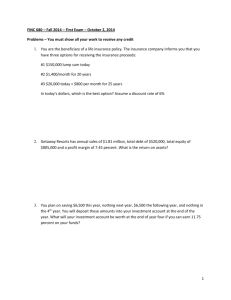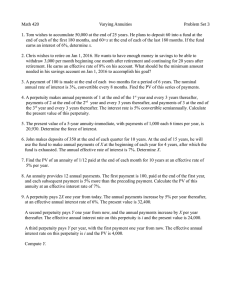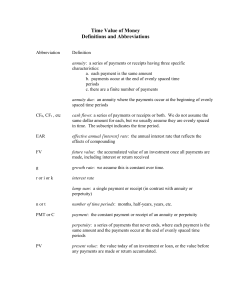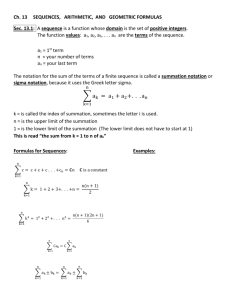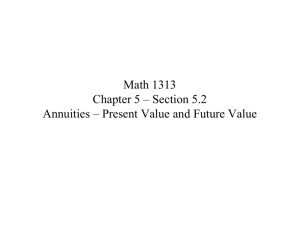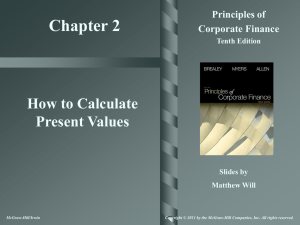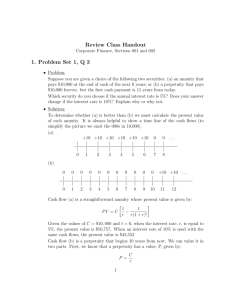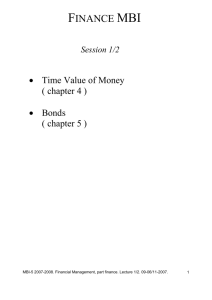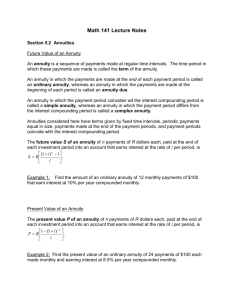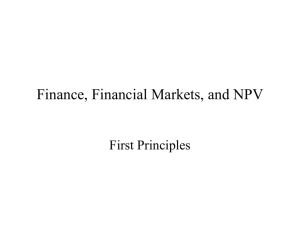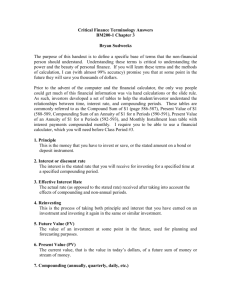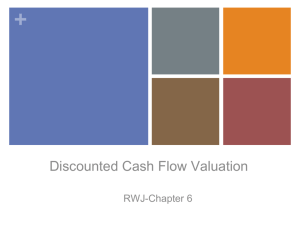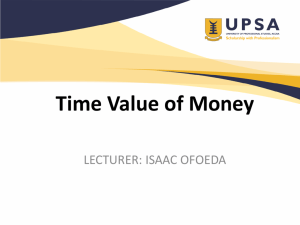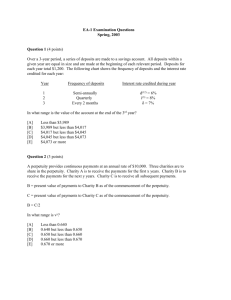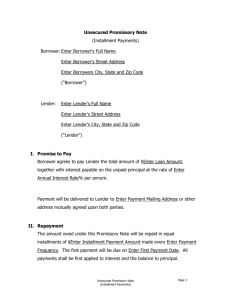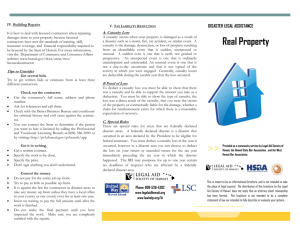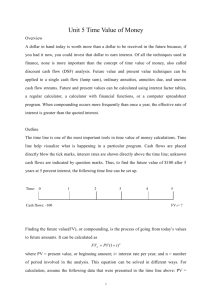12 Financial mathematics, simple and compound interest
advertisement
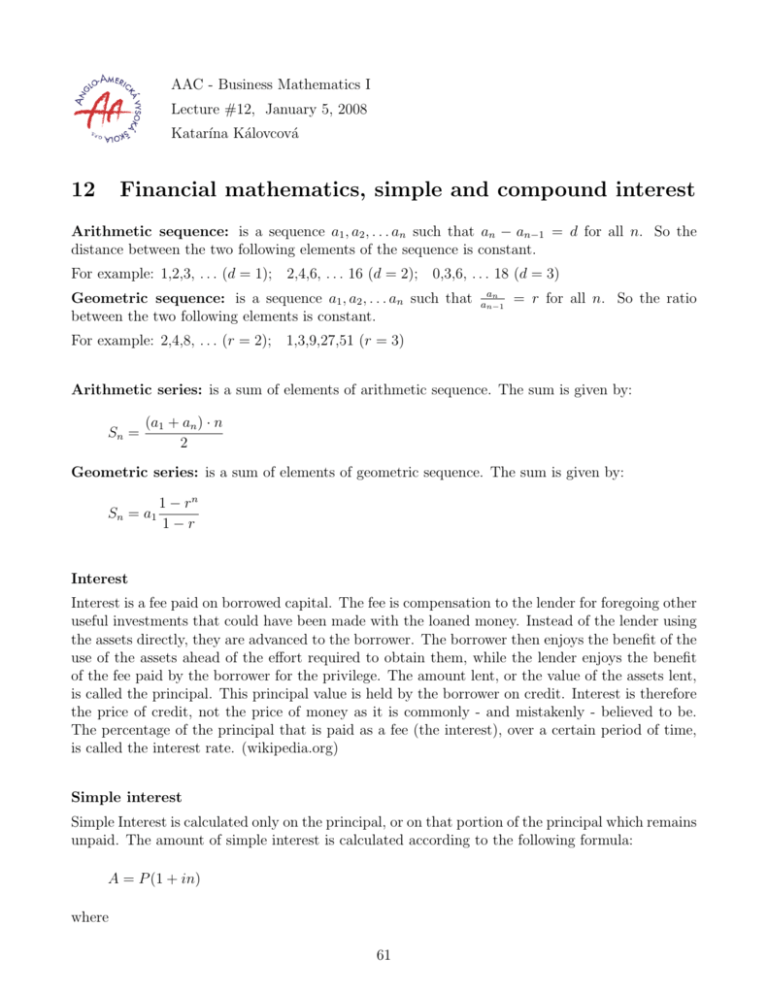
AAC - Business Mathematics I Lecture #12, January 5, 2008 Katarı́na Kálovcová 12 Financial mathematics, simple and compound interest Arithmetic sequence: is a sequence a1 , a2 , . . . an such that an − an−1 = d for all n. So the distance between the two following elements of the sequence is constant. For example: 1,2,3, . . . (d = 1); 2,4,6, . . . 16 (d = 2); 0,3,6, . . . 18 (d = 3) Geometric sequence: is a sequence a1 , a2 , . . . an such that between the two following elements is constant. an an−1 = r for all n. So the ratio For example: 2,4,8, . . . (r = 2); 1,3,9,27,51 (r = 3) Arithmetic series: is a sum of elements of arithmetic sequence. The sum is given by: Sn = (a1 + an ) · n 2 Geometric series: is a sum of elements of geometric sequence. The sum is given by: Sn = a1 1 − rn 1−r Interest Interest is a fee paid on borrowed capital. The fee is compensation to the lender for foregoing other useful investments that could have been made with the loaned money. Instead of the lender using the assets directly, they are advanced to the borrower. The borrower then enjoys the benefit of the use of the assets ahead of the effort required to obtain them, while the lender enjoys the benefit of the fee paid by the borrower for the privilege. The amount lent, or the value of the assets lent, is called the principal. This principal value is held by the borrower on credit. Interest is therefore the price of credit, not the price of money as it is commonly - and mistakenly - believed to be. The percentage of the principal that is paid as a fee (the interest), over a certain period of time, is called the interest rate. (wikipedia.org) Simple interest Simple Interest is calculated only on the principal, or on that portion of the principal which remains unpaid. The amount of simple interest is calculated according to the following formula: A = P (1 + in) where 61 A is the amount of money to be paid back P is the principal i is the interest rate (expressed as decimal number) n the number of time periods elapsed since the loan was taken For example, imagine Jim borrows $23,000 to buy a car and that the simple interest is charged at a rate of 5.5% per annum. After five years, and assuming none of the loan has been paid off, Jim owes: A = 23000(1 + 0.055 × 5) = 29325 At this point, Jim owes a total of $29,325 (principal plus interest). Compound interest In the short run, compound Interest is very similar to Simple Interest, however, as time goes on difference becomes considerably larger. The conceptual difference is that the principal changes with every time period, as any interest incurred over the period is added to the principal. Put another way, the lender is charging interest on the interest. A = P (1 + i)n In this case Jim would owe principal of $30,060. 62 Savings, loans, project evaluations Time value of money The time value of money represents the fact that, loosely speaking, it is better to have money today than tomorrow. Investor prefers to receive a payment today rather than an equal amount in the future, all else being equal. This is because the money received today can be deposited in a bank account and an interest is received. Present value of a future sum PV = FV (1 + i)n where: P V is the value at time 0 F V is the value at time n i is the rate at which the amount will be compounded each period n is the number of periods Present value of an annuity The term annuity is used in finance theory to refer to any terminating stream of fixed payments over a specified period of time. Payments are made at the end of each period. 1 1 1 − (1+i)n 1 1 1 1 1 − (1+i)n P V (A) = A +A + . . . + A = A = A 1 (1 + i) (1 + i)2 (1 + i)n (1 + i) 1 − 1+i i where: P V (A) is the value of the annuity at time 0 A is the value of the individual payments in each compounding period i is the interest rate that would be compounded for each period of time n is the number of payment periods Present value of a perpetuity A perpetuity is an annuity in which the periodic payments begin on a fixed date and continue indefinitely. It is sometimes referred to as a ”perpetual annuity” (UK government bonds). The value of the perpetuity is finite because receipts that are anticipated far in the future have extremely low present value (present value of the future cash flows). Unlike a typical bond, because 63 the principal is never repaid, there is no present value for the principal. The price of a perpetuity is simply the coupon amount over the appropriate discount rate or yield, that is P V (P ) = A i Future value of a present sum F V = P V (1 + i)n Future value of an annuity F V (A) = A (1 + i)n − 1 i Example: One hundred euros to be paid 1 year from now, where the expected rate of return is 5% per year, is worth in today’s money: PV = FV 100 = = 95.23. n (1 + i) 1.05 So the present value of 100 euro one year from now at 5% is 95.23. Example: Consider a 10 year mortgage where the principal amount P is $200,000 and the annual interest rate is 6%. The number of monthly payments is n = 10 years × 12 months = 120 months The monthly interest rate is i= 6% per year = 0.5% per month 12 monhs per year P V (A) = A A = 200000 1− 1 (1+i)n i ⇒ A = P V (A) i 1− 1 (1+i)n = P V (A) 0.005(1 + 0.005)120 = $2220.41 per month. (1 + 0.005)120 − 1 64 i(1 + i)n (1 + i)n − 1 Example: Consider a deposit of $ 100 placed at 10% annually. How many years are needed for the value of the deposit to double? F V = P V (1 + i)n 200 = 100(1 + 0.1)n 200 1.1n = =2 100 ln 1.1n = ln 2 n ln 1.1 = ln 2 ln 2 n= = 7.27 years ln 1.1 Example: Similarly, the present value formula can be rearranged to determine what rate of return is needed to accumulate a given amount from an investment. For example, $100 is invested today and $200 return is expected in five years; what rate of return (interest rate) does this represent? F V = P V (1 + i)n 200 = 100(1 + i)5 200 (1 + i)5 = =2 100 (1 + i) = 21/5 i = 21/5 − 1 = 0.15 = 15% Example: A manager of a company has to choose one of two possible projects. Project A requires immediate investment $500 and yields returns $200, $300, and $400 in the following three years. For project B it is necessary to invest $400 now and the expected returns in the next three years are $400, $100 and $50. Supposed that an interest rate is 10%. Which project should the manager choose? Having time value of money in mind, manager should choose project with a higher present value. P VA = −500 + 300 400 200 300 400 200 + + = −500 + + + = 2 3 2 1 + i (1 + i) (1 + i) 1.1 1.1 1.13 = −500 + 182 + 248 + 300 = 230 P VB = −400 + 400 100 50 400 100 50 + + = −400 + + + = 2 3 2 1 + i (1 + i) (1 + i) 1.1 1.1 1.13 = −400 + 364 + 83 + 38 = 85 Project A has a higher present value and hence should be chosen. 65
